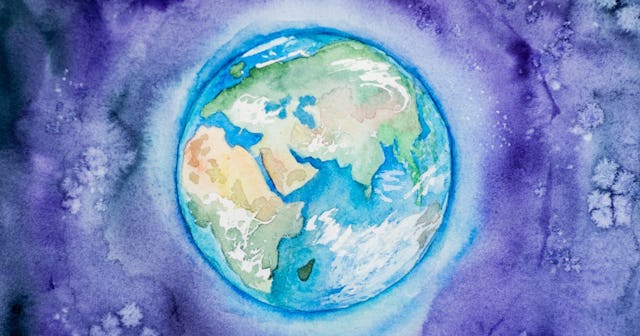10 Well-Rounded Earth Coloring Pages That Make Every Day Earth Day

Sure, you live on Planet Earth (most of the time), but what do you really know about it? How often do you take time to appreciate it? Earth Day is fantastic, but we should truly be thankful to Mother Earth and celebrate her 24/7/365. After all, without her, we wouldn’t exist — at least not in this solar system. How do you instill that sense of awe and appreciation into your kiddos? By teaching them about all the goodness that Earth has to offer, of course. Littler kids may not understand facts about the mantle or the ozone. They may, however, appreciate how pretty she looks on paper. Enter our collection of Earth coloring pages!
From her life-sustaining jungles and rainforests to her air-cleaning trees, Earth is much more than just a roundish rock orbiting the sun. She’s truly magical. So, while your preschooler practices their coloring skills (a vital part of kindergarten readiness), you can use these free printables to tell them a bit about the planet they inhabit. These facts will surely earn more questions than answers, but isn’t that what learning is all about?
If your future astronomer blows through these coloring pages, let them explore Earth’s wonders with mountain coloring pages, tree coloring pages, ocean coloring pages, flower coloring pages, and volcano coloring pages.
Free Printable Earth Coloring Pages
Earth Page No. 1
No, Earth isn’t flat, but it isn’t perfectly round either! A scientific blend of gravity and centrifugal force contributes to our planet having a bit of a bulge around its middle. That’s right, boo — Mother Earth has a FUPA. We only love her more for it.
Earth Page No. 2
Speaking of Earth’s girth, do you know the Earth’s circumference? At the equator, our planet is nearly 25,000 miles around. That means you’d need roughly eight oil changes to drive your Subaru around the Earth at its widest point. (You know, if you could.)
Earth Page No. 3
We recently learned that some of the oldest trees on the planet are in California, where sequoia trees age about 4,000 to 5,000 years. The oldest rock on Earth, though, is significantly older. The rocks that make up the Nuvvuagittuq Belt in Quebec, Canada, are approximately 4.28 billion years old. In other words, they’re almost as old as Earth herself.
Earth Page No. 4
On the subject of rocks, the Earth is covered in giant rock-like structures called tectonic plates. The movement of those plates triggers everything from earthquakes to the formation of mountains. Scientists also based the concept of Earth’s continents on the location and area of those plates. And did you know the Earth’s core is just as hot as the sun’s surface? They’re both about 10,000 degrees!
Earth Page No. 5
When the tectonic plates shift, they can create earthquakes. The world’s most powerful earthquake happened in 1960 in Chile and measured as a 9.5 magnitude on the Richter scale. Earthquakes can be quite devastating, not just because of the damage their shaking causes but also due to the tsunamis they can trigger.
Earth Page No. 6
Of course, Earth is much more than just rock. Sometimes, it’s ice! For instance, one ice-covered place on Earth is the continent of Antarctica. Antarctica may not hold the record for the coldest ever reported temperature (that goes to Russia), but it is the place with the coldest sustained temperatures. Antarctica regularly records temperatures of -100 degrees. Brrrrr! Another interesting fact about Antarctica? It’s considered a desert. Most people think of deserts as hot and sandy, but the actual definition of a desert is just a place lacking precipitation. Because Antarctica is so cold, they only average about two inches of precipitation yearly.
Earth Page No. 7
The desert you’re more used to thinking about probably looks like Death Valley in the American Southwest. In addition to being extremely hot, Death Valley is home to “walking rocks.” What does that mean? This particularly flat desert holds some giant boulders that, without any help from man, move across the ground on their own and leave trails behind. There are a few theories as to how this happens — but we prefer to blame “strange forces.”
Earth Page No. 8
Some things seem permanent, like a mother’s love or that monthly student loan bill. You may even think of the Earth’s poles this way — except, Earth’s poles aren’t permanent at all. They regularly flip-flop and wobble. No worries, though. “Regularly” is a pretty broad term when something is several billion years old. This movement typically happens about every 200,000 to 300,000 years, and it takes several centuries (not all at once).
Earth Page No. 9
Remember those tectonic plates that help make up the continents? Did you know that, at one point in Earth’s history, they used to all be stuck together in one supercontinent? Scientists and historians refer to this “supercontinent” as “Pangea.” (The word Pangea is made up of two Greek words: pan means “all,” and gia means “Earth.”) It broke apart about 180 to 200 million years ago, with the first crack creating the North Atlantic Ocean. This supercontinent is often used to explain why similar animals exist on separate continents.
Earth Page No. 10
Think our gorgeous Earth is unique in her existence? Think again! While Earth may be unique in our solar system, most scientists believe there are surely more Earth-like planets in other galaxies. Whether they have life like ours, though, is an entirely different theory. (That’s a conversation that begs to be followed up with our alien coloring pages.)
Click here to print all of the Earth coloring pages at once!
This article was originally published on